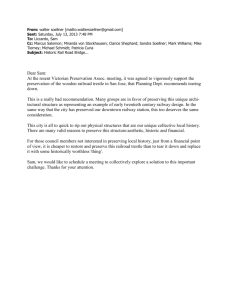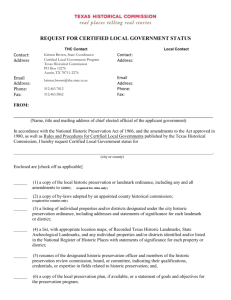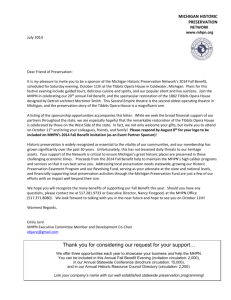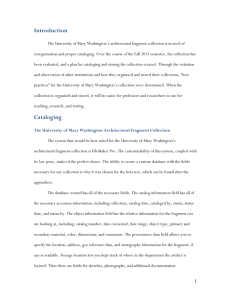Mission of the Architectural Fragment Collection 3
advertisement
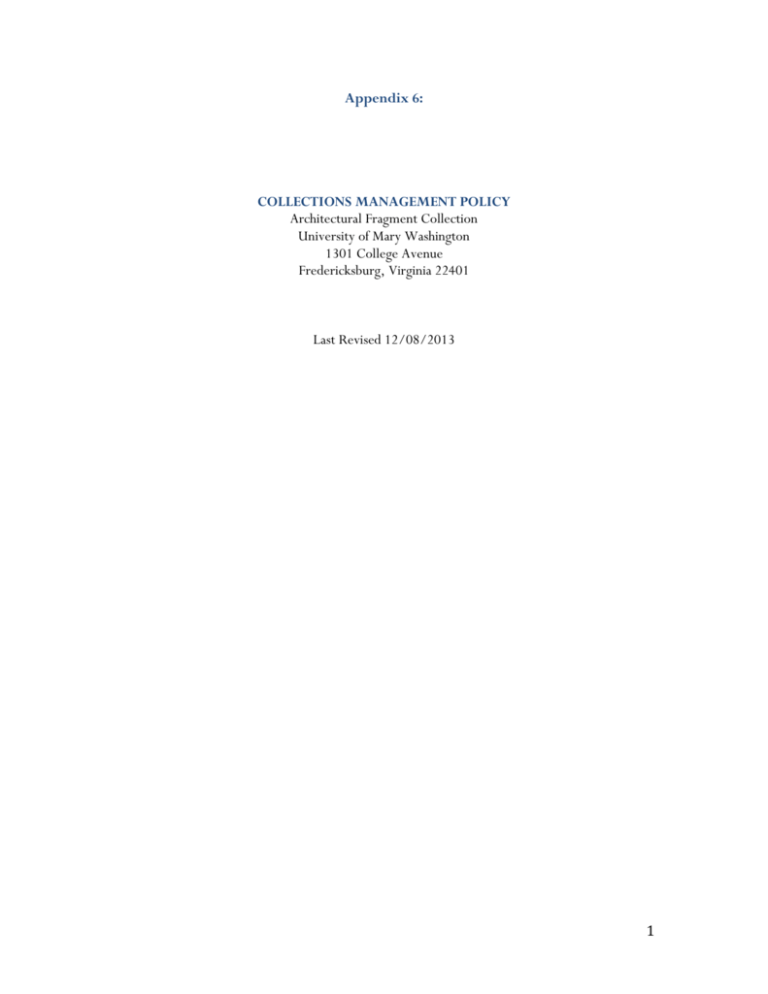
Appendix 6: COLLECTIONS MANAGEMENT POLICY Architectural Fragment Collection University of Mary Washington 1301 College Avenue Fredericksburg, Virginia 22401 Last Revised 12/08/2013 1 TABLE OF CONTENTS Statement of Purpose ............................................................................. 3 Mission of the Architectural Fragment Collection ................................3 Goal of the Architectural Fragment Collection ..................................... 3 Responsibility and Authority for the Collection ...................................3 Ethical Standards .................................................................................... 3 Scope of Collection ................................................................................ 3 Acquisition Policy .................................................................................. 4 Deaccession Policy .................................................................................4 Inventory Procedures .............................................................................5 Management of Collection Records .......................................................5 Care and Conservation ........................................................................... 5 Environmental Controls .........................................................................5 Access .....................................................................................................5 Staff .........................................................................................................5 Public ......................................................................................................6 Sampling and testing policy ...................................................................6 2 Statement of Purpose The purpose of this policy is to identify how the Architectural Fragment Collection of the University of Mary Washington will be managed. The policy is intended to serve as a guide to the development, management, and preservation of the collection to achieve the overall mission of the collection. This policy will identify the duties and responsibilities of the staff, and others who are allowed to access the collection. Mission of the Architectural Fragment Collection The mission of the architectural fragment collection at the University of Mary Washington is to provide a hands-on, educational resource for students and those interested in researching historic building technologies and techniques. Goals of the Architectural Fragment Collection Provide examples of historic building technologies and techniques found throughout the Rappahannock River Valley region, in order to reinforce traditional academic study. Provide material for both hands-on education and research that includes scientific testing. Facilitate accessibility to often inaccessible historic materials. Use the collection to begin to develop building technology and technique chronologies to assist in dating and site interpretation. Responsibility and Authority for the Collection Gary Stanton – Chair of the Department of Historic Preservation Michael Spencer – Assistant Professor of Historic Preservation Douglas Sanford – Professor of Historic Preservation Andrea Smith – Assistant Professor of Historic Preservation Christina Turdean – Assistant Professor of Historic Preservation Ethical Standards Faculty should protect the integrity of objects and thus guarantee that they continue to be reliable evidence of the past. Faculty should appraise, select, and maintain objects in their historical, legal, and administrative context, thus retaining the principle of provenance, preserving, and making evident the original relationships of documents. Faculty should protect the authenticity of objects during processing, preservation, and use. Faculty should ensure the continuing accessibility and intelligibility of objects. Faculty should record, and be able to justify, their actions on objects. Faculty should promote the widest possible access to objects and provide an impartial service to all users. 3 Faculty should respect both access and privacy, and act within the boundaries of relevant legislation. Faculty should use the special trust given to them in the general interest and avoid using their position to unfairly benefit themselves or others. Faculty should pursue professional excellence by systematically and continuously updating their knowledge, and sharing the results of their research and experience. Faculty should endeavor to develop their professional understanding and expertise, to contribute to the body of professional knowledge, and to ensure that those whose training or activities they supervise are equipped to carry out their tasks in a competent manner. Faculty should seek to enhance cooperation and avoid conflict with their professional colleagues and to resolve difficulties by encouraging adherence to collection standards and ethics. Faculty should cooperate with members of related professions based on mutual respect and understanding. Scope of Collection The collection contains examples from a variety of building technologies. Nails, bricks, mortar, wood shingles, masonry features, doors, windows, tools, and a variety of other objects are part of the collection. All artifacts are from the Rappahannock River Valley Region and range in date from the time of settlement to present day. These objects are used for teaching in the classroom both for examples of building technologies and for learning scientific testing of materials. The objects are also available for research. Acquisition Policy Faculty in the Historic Preservation Department will make all decisions regarding acquisitions to the collection. Acquisitions will be made based off the following criteria: Provide examples of historic building technologies and practices found in the Rappahannock River Valley region from the time of settlement to the modern day. The object must be in proper condition to convey technology or manufacture or convey information about a locally or regionally significant structure. Objects that are unique to the area or to building technologies will be accepted into the collection. Objects that are part of a donation must be properly documented in order to be accepted into the collection. Elements that require continuous maintenance will not be added to the collection due to the inability to provide adequate upkeep. Deaccession Policy 4 Faculty in the Historic Preservation Department will make all decisions regarding deaccessions from the collection. Deaccessions will be made based off the following criteria: Objects will be deaccessioned if they are found to no longer fit the mission of the collection. Objects will be deaccessioned if there is no longer proper storage space for them or if they are in condition that would require advanced preservation or conservation. Objects will be deaccessioned if they are found to be repetitive of other objects, particularly if the other objects are in better condition for teaching and/or research. Objects will be deaccessioned if they are no longer in condition to be used for hands-on teaching or research. Procedure for removal: The Historic Preservation faculty is in charge of initiating the removal process, however the entire faculty should be consulted on the removal at department meetings. Proper documentation of the removal should be done in order to ensure that the records of the collection are up to date and correct. Inventory Procedures Developing and maintaining an accurate inventory is the responsibility of the Department faculty. Each object in the collection is given a catalog number and storage location. Storage locations for each object are maintained in the collection database. The database will be updated as objects are moved or deaccessioned so that up-to-date information is available at all times. In addition, the faculty, or authorized personnel, will conduct a wall-to-wall inventory of the collection on a biannual basis. Management of Collection Records Collection records will include: legal status of objects (bill of sale, deed of gift, etc.), descriptive and historical data, condition reports and conservation history, correspondence regarding acquisition, documents regarding deaccession, photographic documentation, and any other records of the object’s use and movement using the cataloging database. Paper records will be stored in a secure cabinet in either the Department Chair’s office or the Curator’s office. Digital records will be stored in the collection database and backed up to a secure location on another computer within the department. Care and Conservation Conservation will be done by the faculty if necessary. If advanced conservation is needed, it will be approved by the department chair or curator of collection. A list of all the objects in the collection and their identification numbers should be kept in a secure location and a backup copy should be kept off-site in the case of an emergency. Environmental Controls If possible, the storage area should be kept locked at all times. Only those who are authorized can gain access, or those who have been approved by the curator or department chair. If possible, natural light should be kept at a minimum. Artificial light should be kept at a minimum to avoid 5 damaging the artifacts. Humidity and temperature should be monitored to provide the best conditions for the objects. Flammable objects or chemicals used for testing should be kept in a secure location in order to prevent damage to objects. Access Only those who have been approved by the curator or department chair are allowed access to the collection and records outside of class. During class, all students are allowed access to the teaching collection. The study collection is only to be accessed by those who have been given permission by the faculty, curator, or department chair. Staff Gary Stanton – Chair of the Department of Historic Preservation Michael Spencer – Assistant Professor of Historic Preservation Douglas Sanford – Professor of Historic Preservation Andrea Smith – Assistant Professor of Historic Preservation Christina Turdean – Assistant Professor of Historic Preservation Public The public will only be granted access to the collection with permission and approval from the Curator or the Department Chair. The public must formally request permission for research by contacting the Department Chair. Sampling and testing policy Sampling and testing is the permanent alteration, removal, or destruction of part or all of an object in the course of research. Sampling and testing are approved as part of classes or for faculty research. Outside testing as part of research must be approved by the Curator of the collection or the Department Chair. 6

